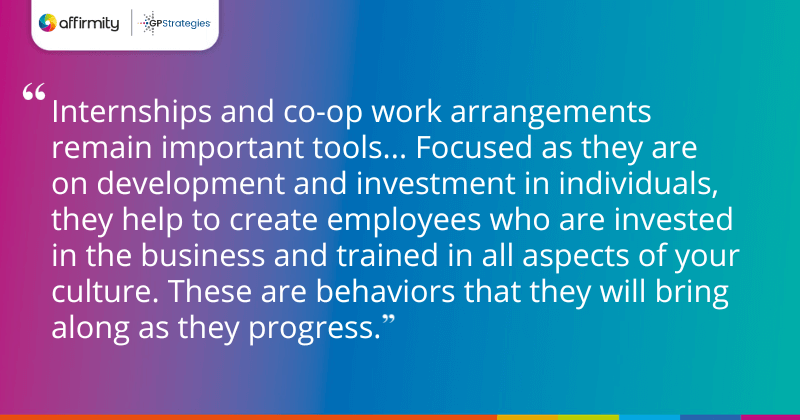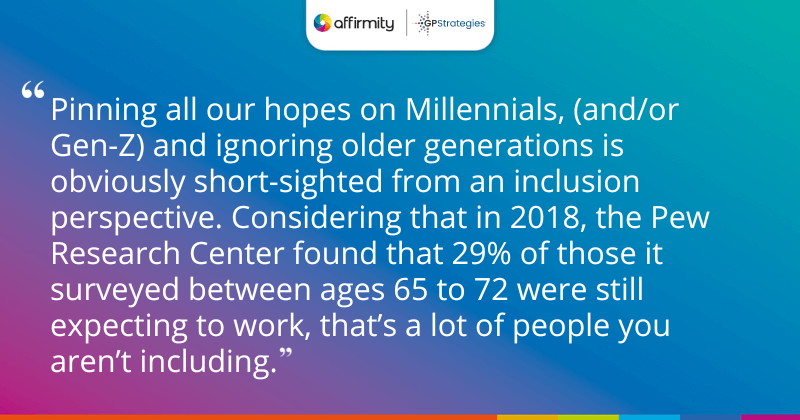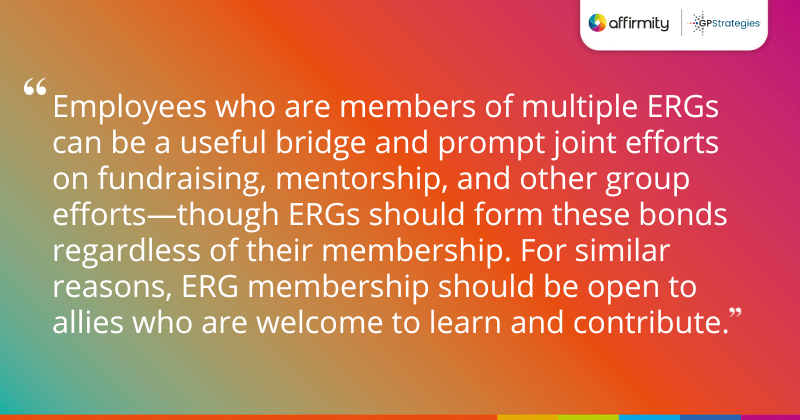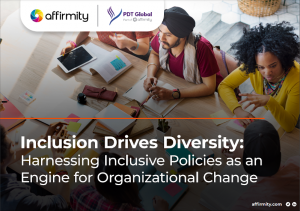Sustaining a diverse organization takes more than simply hiring for diversity—those employees must feel fairly treated, safe, empowered, and valued if they’re going to stay. What’s the best way of cultivating these feelings? In this article, we’ll explore how you can do this by focusing on inclusive policies and expanding the range of opportunities available to all employees.
1) Creating a Diverse Pipeline Through Retention
Despite the collapse of the reality (and the universal desirability) of a “job for life”, maximizing retention is still an important part of how businesses create a culture—inclusive or otherwise. One important way to create a diverse pipeline is to use the hiring tools available to you with the greatest retention potential. Internships and co-op work arrangements remain important tools, with the staying power of hires from such programs higher than the general population.
For example, in the 2020 edition of its annual internship and co-op survey, the National Association of Colleges and Employers reported a one-year retention rate of 68.7% for interns and 54.2% for co-ops when hired off of an internal arrangement. This compares favorably with hires with no internship or co-op experience (either internal or external to the hiring company): only 40.3% of such hires were retained.
In the same survey, five-year retention rates of internal arrangement were 42.2% for interns and 31.6% for co-ops. The five-year retention rate for those with no experience is 29.1%.
Assuming you can ensure a diverse intake into these arrangements, they can be a good first step towards fostering a sense of inclusion. Focused as they are on development and investment in individuals, they help to create employees who are invested in the business and trained in all aspects of your culture. These are behaviors that they will bring along as they progress.
CONSIDERING PAY EQUITY | ‘Workplaces That Work: How to Create a Culture That Embraces Pay Equity’

2) Multigenerational Inclusion: Building Diversity and Inclusion at Different Stages in Your Organization
While working to ensure that diverse and inclusive practices are drawn up from the junior levels of the business along with the employees who learn them, an approach that neglects other age groups is inadequate. After all, age is itself an area where your practices need to be inclusive—and it’s one that’s often overlooked. This is worth bearing in mind alongside the expectation that a growing Millennial workforce will increasingly bring new ideas about inclusion up the hierarchy.
One widely repeated claim is that by 2025, Millennials will account for 75% of the workforce. The math on this claim doesn’t actually stand up to scrutiny—we’re more likely already at ‘peak Millennial’ at just 41.4% of the workforce (though if we commit the sin of calling members of Generation Z “Millennials” we can stretch to 61.8% by 2025). Nonetheless, the observations that come with the claim ring true: Millennials will increasingly occupy leadership positions, and bring a different perspective, and expectations on diversity and inclusion.
Whatever percentage of the workforce they form, pinning all our hopes on Millennials, (and/or Gen-Z) and ignoring older generations is obviously short-sighted from an inclusion perspective. The oldest Millennials will only be 45 in 2025—considering that in 2018, the Pew Research Center found that 29% of those it surveyed between ages 65 to 72 were still expecting to work, that’s a lot of people you aren’t including.
One World Economic Forum article makes some recommendations we would echo when organizations aim to promote inclusion in a multi-generational workforce:
- An age- and stage-inclusive reassessment of policies across recruitment, assessment, retention, compensation, life-long learning, health, and retirement
- For example, policies that support caregivers in employment who are simultaneously earning a living and caring for a family member or friend
- A review of your training and development approach to better meet the needs of all age groups
- “Returnship” programs that broaden options for groups returning to work (such as those returning from parental leave or retirement)
As explored in our parent company’s white paper, “A Human Framework for Reskilling: How the 5 Seismic Forces Persist in a Post-Pandemic World”, employees are working longer while subject to growing complexity and a higher pace of change. Failing to invest in reskilling options for employees at all career stages leaves some of your greatest assets underutilized. Or worse, unengaged, and ready to quit.
LEARN MORE ABOUT EFFECTIVE DE&I PRACTICES | ‘11 DE&I Practices Strongly Linked to Successful Programs’

3) Emphasize Cross-Cultural Opportunities
Training and reskilling employees is just one of the tools to consider in a multi-generational workforce. The potential for cross-generational exchange is immense, and fits into a wider picture of cross-cultural opportunity. Older employees have invaluable working experience to share with younger employees, and younger employees have technical skills of use to their older colleagues. Finding the right venues for these and other exchanges is important. These could include:
Purposefully Creating Diverse Teams.
68% of employers surveyed by AARP International expressed willingness to do this with mixed-age teams specifically. One study published in the Harvard Business Review suggested that teams with greater cognitive diversity solve problems more quickly. Though this type of diversity is described as “independent of education, culture or other social conditioning”, the dangers of “like-minded” teams and “recruiting in our own image” were highlighted.
Even supposing that diverse teams in the more traditional sense aren’t a guarantee of quicker business results, it stands to reason that they increase the number of perspectives and the pool of cultural knowledge. Better business results aren’t always solely related to efficiency.
Mentorship and Reverse-Mentorship
One Forbes article boldly claims ‘The Key to Diversity and Inclusion is Mentorship’—and it’s certainly a powerful tool. The identity of a mentor is a meaningful variable: a mentor from the same minority group as the mentee may be able to share relevant advice others may miss. However, cross-cultural mentorship shouldn’t be underestimated. Both stand to benefit from the exchange of experiences alongside the professional association.
Contrary to the assumption that mentors will be older and more advanced in their careers than their mentees, the potential for younger employees to mentor more senior employees—so-called ‘reverse-mentorship’—is significant. Harvard Business Review notes that this isn’t just about “sharing knowledge about technology”, but also “how senior executives think about strategic issues, leadership, and the mindset with which they approach their work.”

Intersectionality and Employee Resource Groups (ERGs)
ERGs have the potential to be a melting pot for all kinds of thinking around diversity. The groups are usually formed around a single specific identity—for example, networks for women, persons of color, working parents, persons with disabilities, LGBTQ+ communities, and more. Memberships inevitably accommodate people with several different characteristics, and their voices can help highlight the concerns that exist at the intersection of those identities.
Employees who are members of multiple ERGs can be a useful bridge and prompt joint efforts on fundraising, mentorship, and other group efforts—though ERGs should form these bonds regardless of their membership. For similar reasons, ERG membership should be open to allies who are welcome to learn and contribute. Finally, it’s also common for groups to have an executive sponsor who can advocate and relay information to the wider executive team.
FURTHER THOUGHTS ON ERGs | ‘5 Key Steps in the Creation, Growth and Evolution of Your ERGs’
Cross-Cultural Training
As ever, it’s important to develop and offer training programs that focus on inclusive communication and behaviors. This training should be tailored to different management and employee levels to ensure the practical advice is of maximum relevance to the audience.
Inclusion Drives Diversity—Keep Reading
These three ideas around nurturing inclusion come from a larger exploration of the topic in our latest ebook, “Inclusion Drives Diversity: Harnessing Inclusive Policies as an Engine for Organizational Change”. Download the full guide and keep reading analysis from our experts on:
- The business case for inclusion, including examples of the impact of its absence
- Why you need to review your hiring and promotion practices
- Pay equity’s continuing role alongside diversity and inclusion
- How to measure and reiterate upon the gains that inclusion brings
Download the full guide today.

